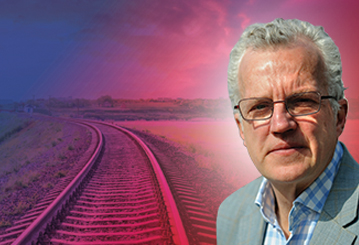I was privileged to spend a couple of days recently being shown round the transport system of Mumbai by my old friend and fellow railway author, Rajendra Aklekar.
It was remarkably enlightening. Mumbai may have lost its trams, but it has a wide variety of rail systems - including the famous and heavily used extensive suburban rail system, an elevated monorail, and both elevated and underground metro lines.
I was privileged to spend a couple of days recently being shown round the transport system of Mumbai by my old friend and fellow railway author, Rajendra Aklekar.
It was remarkably enlightening. Mumbai may have lost its trams, but it has a wide variety of rail systems - including the famous and heavily used extensive suburban rail system, an elevated monorail, and both elevated and underground metro lines.
An entire metro network is being constructed, with four lines already completed and a further eight under construction. While the early metro lines were elevated, the new partially opened line 3 is being built to a standard which almost matches the Elizabeth line.
We travelled on the section under the airport which has opened. The ride was extremely smooth, and there were doors protecting the track at all the platforms, which were almost as long as those on the Elizabeth line.
The stations have been built on a grand scale, with the expectation that footfall will be heavy.
It was most impressive, especially in a city where above ground the road network is often at a standstill, the suburban network is creaking under the strain of overuse and underinvestment, and the standard of the road surface is at times little better than a desert track.
I was impressed too with the monorail. This technology has never really taken off, presumably because it is more expensive than rail, but the line in Mumbai was built because it is able to deal with bends that would be far too tight for a conventional railway. Interestingly, some of the newer metro lines have not attracted as many people as expected because they are more expensive than the suburban railway network, where the fares (which have not risen for more than a decade) are just nine rupees (9p) for every ten kilometres.
And inevitably, much of the transport money has been absorbed by an astonishing new road running along the coast, with a 5km tunnel, out to the airport.
As always happens with new roads, it offered incredibly fast running - until about 4km from the airport, when it got so busy that it took half an hour to cover that final distance.
I am now heading for China at the end of this month, for meetings with senior railway officials. And I will report on the amazing progress that rail has made in the country, with 45 cities and towns boasting a metro system and nearly 50,000km (31,000 miles) of high-speed line, carrying ten million people every day. Dream on.
Login to continue reading
Or register with RAIL to keep up-to-date with the latest news, insight and opinion.


















Login to comment
Comments
No comments have been made yet.